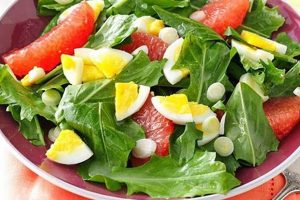A dish combining the sweetness of fresh or frozen peas with the savory, smoky flavor of bacon creates a delightful contrast in textures and tastes. Often, this salad incorporates other ingredients, such as red onion for sharpness, cheese for creaminess, and a vinaigrette for tang. Variations may include different cheeses (e.g., feta, cheddar), herbs (e.g., mint, chives), and other vegetables (e.g., bell peppers, water chestnuts).
This type of salad offers a balance of nutrients and flavors, providing protein from the bacon, vitamins and fiber from the peas, and healthy fats from the dressing. Its versatility makes it suitable for various occasions, from casual lunches and potlucks to more formal gatherings. Historically, pea salad variations have been present in numerous cultures, reflecting the widespread availability and adaptability of peas. The addition of bacon elevates the dish, adding a richer dimension to the flavor profile.
Further exploration will cover specific ingredient combinations, preparation methods, and serving suggestions for maximizing the enjoyment of this versatile and flavorful salad. Nutritional information and variations catering to specific dietary needs will also be addressed.
Tips for a Successful Pea and Bacon Salad
Achieving optimal flavor and texture requires attention to detail throughout the preparation process. The following tips offer guidance for creating a truly exceptional salad.
Tip 1: Blanch the Peas: Briefly immersing fresh peas in boiling water, followed by an ice bath, preserves their vibrant green color and tender-crisp texture. Frozen peas can be thawed under cold running water.
Tip 2: Crisp the Bacon Properly: Cook bacon until perfectly crisp to provide a satisfying textural contrast to the peas. Drain thoroughly to prevent a greasy salad.
Tip 3: Balance Flavors: A sharp or tangy element, such as red onion or a vinaigrette dressing, cuts through the richness of the bacon and sweetness of the peas.
Tip 4: Consider Cheese Selection: Feta cheese adds a salty, briny flavor, while cheddar provides a sharper, nuttier profile. Experiment to find a preferred complement.
Tip 5: Enhance with Fresh Herbs: Chopped fresh mint or chives contribute a refreshing herbal note that elevates the overall flavor complexity.
Tip 6: Don’t Overdress: Add dressing gradually, tasting as you go, to avoid a soggy salad. The ingredients should be lightly coated, not swimming in dressing.
Tip 7: Chill Before Serving: Chilling the salad allows the flavors to meld and enhances the refreshing quality of the dish, particularly beneficial in warmer weather.
By following these tips, one can create a balanced and flavorful salad showcasing the harmonious combination of peas and bacon. Attention to these details ensures a delightful culinary experience.
These techniques contribute to a successful outcome, enhancing both the taste and presentation of the final dish. The subsequent sections will provide specific recipe variations and serving suggestions.
1. Fresh Ingredients
Ingredient quality significantly impacts the overall flavor and enjoyment of a green pea bacon salad. Freshness plays a crucial role, affecting not only taste but also texture, appearance, and nutritional value. Utilizing peak-season produce elevates the salad from simple to exceptional.
- Peas
Fresh or frozen peas, when properly handled, contribute sweetness and a tender-crisp texture. Fresh peas, quickly blanched, retain vibrant color and optimal flavor. Frozen peas, thawed gently, offer convenience without significant quality compromise. Using canned peas is discouraged as they often possess a mushy texture and less vibrant flavor.
- Bacon
High-quality bacon, preferably thick-cut, provides a savory, smoky depth. Proper cooking renders the fat, yielding a crispy texture that contrasts pleasantly with the peas. Avoiding pre-cooked or overly processed bacon ensures optimal flavor and texture.
- Produce
Other fresh ingredients, such as red onion, bell peppers, or chives, introduce complementary flavors and textures. Crisp, vibrant produce enhances the salad’s appeal and contributes essential nutrients. Wilted or bruised produce detracts from the overall quality and should be avoided.
- Herbs
Fresh herbs, like mint or chives, elevate the salad with aromatic complexity. Their bright, clean flavors enhance the other ingredients without overpowering the delicate balance. Dried herbs can be substituted in a pinch, but fresh herbs offer superior flavor and aroma.
Prioritizing fresh, high-quality ingredients significantly contributes to a superior green pea bacon salad. The interplay of fresh flavors and textures creates a more enjoyable and satisfying culinary experience. Careful ingredient selection elevates the final dish, showcasing the inherent qualities of each component.
2. Crisp Bacon
Crisp bacon plays a crucial role in a successful green pea salad, providing a textural and flavor counterpoint to the sweetness of the peas and other components. The rendering of fat during cooking creates a desirable crispness that contrasts with the softer textures of the vegetables. This textural interplay enhances the overall sensory experience. Furthermore, the Maillard reaction occurring during bacon cooking develops complex savory and umami notes, adding depth to the salad’s flavor profile. A salad with limp, undercooked bacon lacks this crucial dimension, resulting in a less satisfying dish. Consider a salad with perfectly crisp bacon alongside blanched peas, crumbled feta, and slivered red onion: the bacon’s crunch provides a delightful contrast to the other ingredients. Conversely, imagine the same salad with soft, chewy bacon the textural harmony is lost, and the overall enjoyment diminished.
The crispness of the bacon also influences the salad’s mouthfeel. Well-cooked bacon shatters slightly when bitten, adding another layer of textural interest. This crispness also prevents the bacon from becoming overly greasy, which can negatively impact the salad’s overall freshness and appeal. The rendered bacon fat, used sparingly, can also contribute to the dressing, adding a subtle smoky richness. Overly rendered bacon, however, can become dry and brittle, losing its desirable flavor and texture. Therefore, achieving the proper degree of crispness is essential for maximizing the bacon’s contribution to the salad.
Achieving optimal crispness requires careful cooking techniques. Pan-frying allows for precise control over the cooking process, ensuring even browning and rendering of fat. Baking in the oven offers a hands-off approach, yielding consistent results. Regardless of the chosen method, monitoring the bacon’s progress is crucial to prevent overcooking or undercooking. Properly cooked bacon elevates the green pea salad, transforming it into a more complex and satisfying dish. The interplay of textures and flavors, driven by the crisp bacon, contributes significantly to the salad’s overall appeal.
3. Balanced Dressing
A balanced dressing is essential for a successful green pea bacon salad, acting as a unifying element that harmonizes the diverse flavors and textures. It provides a cohesive backdrop for the sweetness of the peas, the saltiness and smokiness of the bacon, and any other additions, such as onion or cheese. A well-crafted dressing elevates the salad beyond a simple combination of ingredients, transforming it into a cohesive and flavorful dish.
- Acidity
Acidity, often derived from vinegar or citrus juice, provides brightness and cuts through the richness of the bacon and any potential sweetness overload from the peas. A touch of lemon juice or apple cider vinegar can invigorate the palate and enhance the other flavors. Too much acidity, however, can overpower the delicate flavors of the peas and other ingredients. The right balance allows the individual components to shine while creating a harmonious whole.
- Sweetness
A touch of sweetness can complement the savory elements of the salad, creating a more complex flavor profile. A small amount of honey or maple syrup can balance the acidity and enhance the overall enjoyment. However, excessive sweetness can mask the other flavors and create an unbalanced profile. The goal is to achieve a subtle sweetness that complements rather than dominates.
- Fat
Fat, typically from oil or rendered bacon fat, contributes richness and helps distribute the flavors throughout the salad. It also creates a more satisfying mouthfeel. A light, flavorful oil, such as extra virgin olive oil, complements the other ingredients without overpowering them. Overly heavy or strongly flavored oils can detract from the delicate balance of flavors. The amount of fat should be carefully considered to avoid a greasy or heavy salad.
- Seasoning
Proper seasoning with salt, pepper, and other spices enhances the overall flavor profile. Salt amplifies the existing flavors, while pepper adds a touch of warmth and complexity. Other spices, such as garlic powder or onion powder, can further enhance the savory notes. However, over-seasoning can mask the delicate flavors of the peas and other ingredients. The key is to use seasoning judiciously to enhance, not overpower, the existing flavors.
By carefully balancing these four elementsacidity, sweetness, fat, and seasoningthe dressing transforms the green pea bacon salad into a harmonious and flavorful dish. The interplay of these components ensures that each ingredient contributes to the overall experience, creating a more satisfying and enjoyable salad. A well-balanced dressing is essential for maximizing the potential of this versatile dish.
4. Proper Pea Preparation
Proper pea preparation is crucial for a successful green pea bacon salad, significantly impacting the final dish’s texture, flavor, and overall appeal. The method employed, whether using fresh or frozen peas, directly influences the salad’s quality. Correctly handled peas contribute a bright, fresh flavor and a pleasing texture, while improperly prepared peas can result in a mushy, bland, or unappetizing salad.
- Fresh Pea Handling
Fresh peas require careful handling to preserve their delicate flavor and vibrant green color. Blanchingbriefly immersing the peas in boiling water followed by an immediate ice bathhalts the cooking process, sets the color, and maintains a tender-crisp texture. Skipping this step can result in overcooked, dull-colored peas within the salad. The blanching process also helps to remove any residual starch, preventing a cloudy appearance in the final dish.
- Frozen Pea Handling
Frozen peas offer convenience but require careful thawing to prevent mushiness. Thawing under cold running water or in a colander in the refrigerator preserves their texture and prevents them from becoming waterlogged. Avoid thawing in hot water or the microwave, as these methods can lead to a mushy texture, diminishing the salad’s appeal. Properly thawed frozen peas retain a similar texture and flavor profile to fresh peas when handled correctly.
- Timing Considerations
Adding peas to the salad at the right time is essential. If added too early, they can become over-dressed and lose their vibrant color. Incorporating them just before serving ensures they maintain their optimal texture and brightness. This timing also prevents the peas from absorbing excess dressing, which can lead to a soggy salad. Considering the timing contributes to both the aesthetic and textural quality of the finished salad.
- Alternative Preparations
While blanching and thawing are the most common methods, alternative preparations can add nuanced flavors. Lightly sauting peas with a touch of butter or garlic can impart a subtle richness, enhancing their sweetness. Alternatively, roasting peas can create a deeper, nuttier flavor profile, providing a unique twist to the traditional salad. Such variations, when executed properly, can elevate the salad beyond the expected, adding depth and complexity.
The interplay of textures and flavors within a green pea bacon salad relies heavily on proper pea preparation. Attention to detail throughout the process ensures that the peas contribute their optimal qualities to the final dish, maximizing both flavor and enjoyment. Whether using fresh or frozen peas, the method of preparation directly influences the salad’s overall success, highlighting the critical role of this seemingly simple step.
5. Complementary Additions
Complementary additions represent a crucial aspect of a green pea bacon salad recipe, impacting the final dish’s overall balance, complexity, and sensory appeal. These additions move beyond the core ingredients of peas and bacon, introducing nuanced flavors, textures, and visual interest. The strategic incorporation of complementary elements elevates the salad from simple to sophisticated, offering a more complete and satisfying culinary experience. Consider the interplay of textures: the crispness of bacon and the potential crunch of additions like croutons or toasted nuts contrast with the tender peas. This textural diversity provides a more engaging mouthfeel. Similarly, incorporating ingredients with contrasting flavors, such as sharp red onion against sweet peas or tangy feta against savory bacon, creates a more dynamic and balanced flavor profile. A salad solely comprised of peas and bacon, while palatable, lacks the depth and complexity achieved through thoughtful additions.
Specific examples illustrate the transformative power of complementary additions. Imagine a green pea bacon salad enhanced with crumbled feta cheese and thinly sliced red onion. The feta contributes a salty, tangy element, while the red onion provides a pungent bite, both contrasting with the sweetness of the peas and the smokiness of the bacon. Alternatively, consider the addition of chopped fresh mint and toasted pecans. The mint introduces a refreshing herbal note, while the pecans offer a buttery crunch and nutty flavor, further enhancing the salad’s complexity. These additions not only introduce new flavors and textures but also contribute to visual appeal, making the salad more enticing. The considered selection of complementary ingredients demonstrates an understanding of flavor pairings and the creation of a balanced sensory experience.
Understanding the role of complementary additions allows for greater control over the final product, enabling customization to suit individual preferences and dietary needs. One might opt for lower-fat cheese, substitute nuts for seeds to address allergies, or incorporate roasted vegetables for added nutritional value. Recognizing the impact of these additions empowers individuals to create a salad that satisfies specific requirements while maintaining a harmonious balance of flavors and textures. The judicious selection of complementary ingredients ultimately determines the salad’s overall success, demonstrating a thoughtful approach to culinary creation. This understanding transforms a simple recipe into a versatile platform for culinary expression.
Frequently Asked Questions
This section addresses common inquiries regarding the preparation and enjoyment of green pea bacon salad.
Question 1: Can frozen peas be used in place of fresh peas?
Frozen peas offer a convenient alternative to fresh peas, particularly when fresh peas are out of season. Proper thawing techniques, such as rinsing under cold water or thawing in the refrigerator, are essential for maintaining texture and preventing mushiness.
Question 2: What type of bacon is recommended?
Thick-cut bacon is generally preferred for its ability to render fat evenly and achieve optimal crispness. The specific type, such as smoked or unsmoked, can be chosen according to personal preference.
Question 3: How can the salad be made less caloric?
Using reduced-fat bacon and opting for a lighter dressing, such as a vinaigrette, can significantly reduce the overall calorie content. Incorporating additional vegetables, like chopped bell peppers or cucumbers, also adds volume and nutrients without significantly increasing calories.
Question 4: How long can the salad be stored?
Properly stored in an airtight container in the refrigerator, green pea bacon salad can typically be kept for up to three days. The texture of the salad may soften slightly over time.
Question 5: Can the bacon be cooked in advance?
Bacon can be cooked in advance and stored in the refrigerator until ready to use. Ensure the bacon is completely cooled before adding it to the salad to prevent wilting the other ingredients.
Question 6: What other vegetables can be added?
Various vegetables complement green pea bacon salad, including chopped bell peppers, diced red onion, halved cherry tomatoes, and sliced cucumbers. The choice of additional vegetables depends on personal preference and desired flavor profiles.
Careful consideration of these frequently asked questions facilitates a more informed approach to preparing and enjoying this versatile salad. Addressing potential concerns enhances the overall culinary experience.
The following section offers several variations on the classic green pea bacon salad recipe.
Green Pea Bacon Salad Recipe
Exploration of this recipe reveals a dish greater than the sum of its parts. Careful consideration of ingredient quality, preparation techniques, and complementary additions elevates the simple combination of peas and bacon to a culinary experience offering nuanced flavors and textures. From the crispness of properly cooked bacon to the bright sweetness of fresh or frozen peas, each element contributes to a harmonious balance. The addition of complementary ingredients, such as tangy cheeses, pungent onions, or fresh herbs, further enhances the complexity and depth of flavor. The importance of a well-balanced dressing, providing acidity, sweetness, and richness, cannot be overstated. A properly prepared green pea bacon salad offers a delightful interplay of flavors and textures, showcasing the potential of simple ingredients when combined thoughtfully.
Culinary exploration often reveals unexpected delights. This recipe, through its adaptability and potential for variation, encourages experimentation and personalization. Whether adhering to a classic preparation or venturing into creative interpretations, the green pea bacon salad offers a canvas for culinary expression. The fundamental principles discussedfreshness, balance, and thoughtful ingredient selectionextend beyond this specific dish, informing a broader understanding of culinary practice and the potential for creativity in the kitchen.






